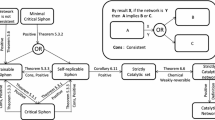Abstract
The particular dynamics of the previously proposed model of a catalytic network formed byn error-prone self-replicative species without and with superimposed competition is analysed. In the first case, two situations are studied in detail: a uniform network in which all the species are inter-coordinated in the same way, and a network with a species differentiated in its catalytic relation with the remaining elements. In the second case, the superimposed competition is introduced at two levels: first, as an asymmetry in one of the network species amplification factor considering a null self-catalytic vector, and secondly, as a non-null self-catalytic vector with no asymmetry in the other propertics of the species. This kind of system does not present complex behaviour and can be adequately deseribed by performing a standard linear analysis, which gives direct information on the asymptotic behaviour of the sytem. Finally, the biological implications of this analysis within the framework of biological evolution are discussed.
Similar content being viewed by others
Literature
Andrade, M. A., A. Garcia-Tejedor and F. Montero. 1991. Study of an error-prone hypercycle formed from two kinetically distinguishable species.Biophys. Chem. 40, 43–57.
Eigen, M. and P. Schuster. 1979.The Hypercycle—A Principle of Natural Self-organization. Berlin: Springer-Verlag.
Farmer, J. D., S. A. Kauffman and N. H. Packard. 1986. Autocatalytic replication of polymers.Physica D 22, 50–67.
García-Tejedor, A., F. Morán and F. Montero. 1987a. Influence of the hypercyclic organization of the error threshold.J. theor. Biol. 127, 393–402.
García-Tejedor, A., R. Castaño, F. Morán and F. Montero. 1987b. Studies on evolutionary and selective properties of hypercycles using a Monte Carlo method.J. molec. Evol. 26, 294–300.
García-Tejedor, A., J. C. Sanz-Nuño, J. Olarrea, F. J. de la Rubia and F. Montero. 1988. Influence of the hypercycle on the error threshold: a stochastic approach.J. theor. Biol. 134, 431–443.
Küppers, B. O. 1983.Molecular Theory of Evolution. Berlin: Springer-Verlag.
Nuño, J. C., M. A. Andrade, F. Morán and F. Montero. 1992. A model of an autocatalytic network formed by error-prone self-replicative species.Bull. math. Biol. 55, 385–415.
Schuster, P. 1991. Dynamics of autocatalytic reaction networks. InMolecular Evolution in Rugged Landscapes: Proteins, RNA and the Immune System, A. S. Perelson and S. A. Kauffman (Eds), pp. 281–306, Santa Fe: Addison-Wesley.
Author information
Authors and Affiliations
Corresponding author
Rights and permissions
About this article
Cite this article
Nuño, J.C., Andrade, M.A. & Montero, F. Non-uniformities and superimposed competition in a model of an autocatalytic network formed by error-prone self-replicative species. Bltn Mathcal Biology 55, 417–449 (1993). https://doi.org/10.1007/BF02460890
Received:
Revised:
Issue Date:
DOI: https://doi.org/10.1007/BF02460890




